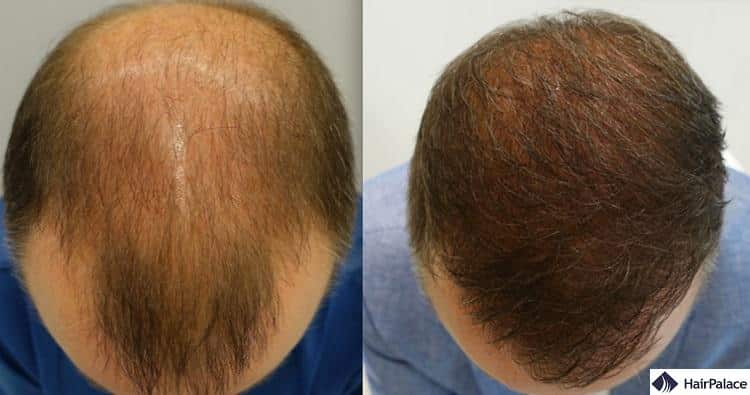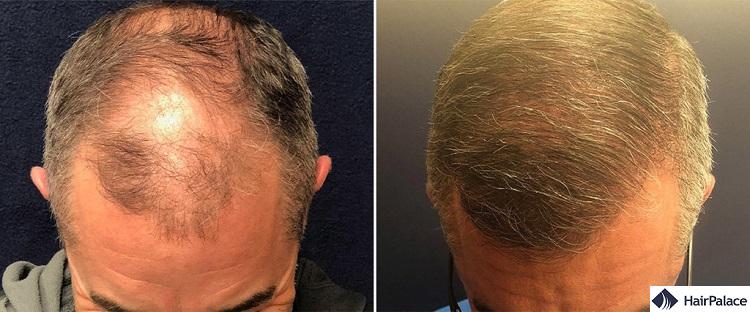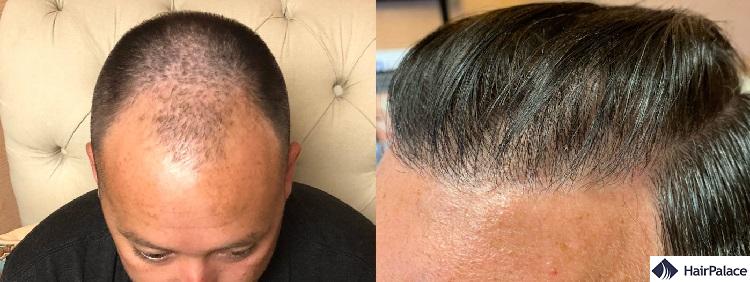FUT Hair Transplant: Everything You Need to Know in 2025
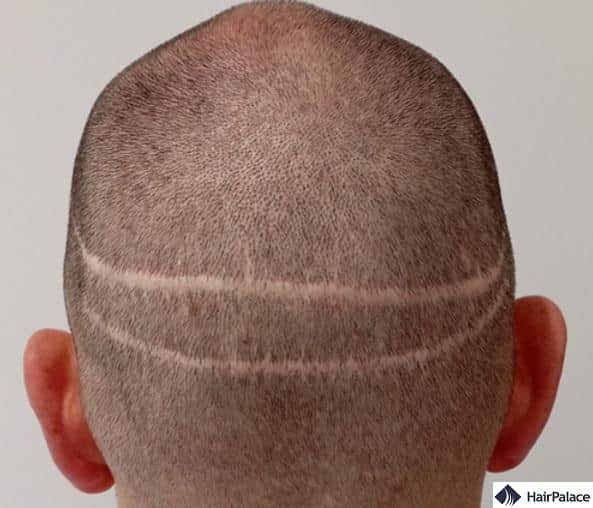
FUT is the oldest method of transplanting hair still in use today.
A strip of scalp containing hair follicles is removed from the donor area, typically the back of the head.
The strip is then divided into individual follicular units under a microscope and transplanted to balding or thinning areas.
FUT can provide a high yield of grafts and natural-looking results, but it leaves a linear scar at the donor site, which can be noticeable if hair is worn very short.
Find out everything you need to know about Follicular Unit Transplantation and see if it’s the best solution for your hair loss.
- Fast facts
- What is it?
- FUT breakdown
- How it works
- Cost
- Who is it for?
- FUT results
- FUE vs FUT procedure
- Side effects
- Recovery after FUT procedure
FUT hair transplant UK at a glance
| Patients in 2022 | 18,000 |
| Most clinics in | London |
| Costs in the UK | from £3000 to £9000 per session |
| Average surgery size | 2500 grafts |
| Procedure | |
| Duration of surgery | 6 to 8 hours |
| Anaesthesia | local |
| Extraction type | strip harvesting with a scalpel |
| Pain | moderate |
| Risks | swelling, numbness of the scalp, infection |
| Scarring | linear scar at the back, visible with short hair |
| Aftercare | |
| Recovery | around 14 days |
| Stitch removal | after 10-14 days |
| Regrowth | starts 3-4 months post-surgery |
| Final result | in 12 to 15 months |
What is Follicular Unit Transplantation?
During Follicular Unit Transplantation, surgeons use a scalpel to remove a section of the skin from the back of the head.
This typically measures between 1 and 1.5 centimetres in width, depending on the hair follicles required to achieve optimal coverage.
They will extract the follicular units from this strip, and prepare them to be implanted into the areas affected by male pattern baldness.
Generally, this procedure is most effective for adding density to larger bald or thinning areas.
The surgeon will close the donor site to heal. The disadvantage of this method is that the patient will have a permanent scar on this spot.
FUT breakdown
János explains the ins and outs of the FUT procedure and explains how it compares to other popular hair transplantation methods.
How does FUT work?
This procedure should last from 4 to 6 hours.
This tends to be a faster process than FUE hair transplants, and most patients remain awake (though they receive a local anaesthetic to numb the affected area).
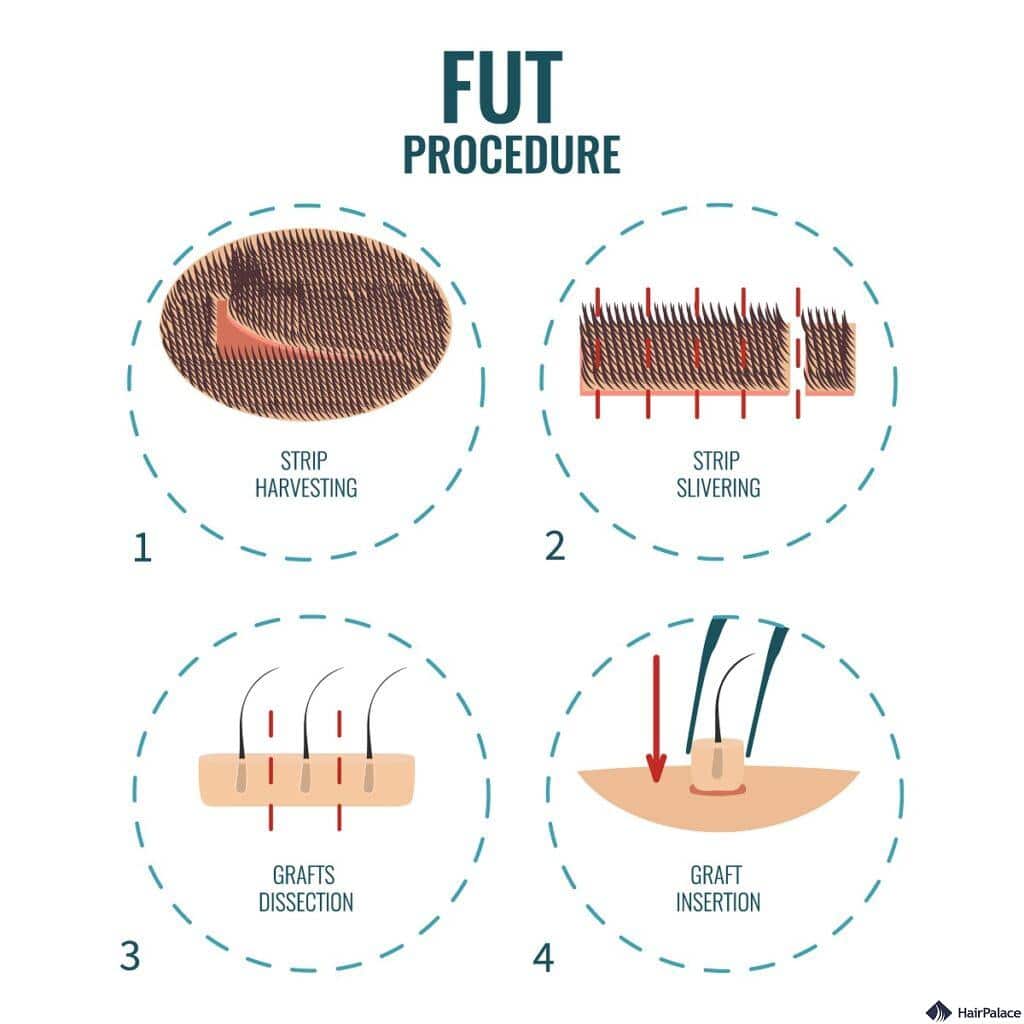
How does the treatment unfold?
- The surgeon will identify the recipient and donor areas, and take photos for future reference.
- The donor hair will be cut to approximately 2 millimetres to allow for easier access.
- The surgeon will remove the strip from the back of the head, ready to extract the follicles.
- All individual follicular units will be removed and prepared for transplantation.
- The site of the extraction will be closed with sutures.
- The surgeon will insert the donor follicles into the thinning areas of the scalp to build a natural pattern.
- Antibiotic treatment will be applied to the scalp before it’s dressed with bandages.
The majority of patients notice results between 6 and 9 months after their surgery, though it can take around one year for some to reach that stage.
FUT hair transplant cost
Follicular Unit Transplantation cost UK ranges from around £3,000 to £9,000, though it may cost more at some clinics.
You will most likely have to pay that out of your pocket as insurance providers and the NHS rarely cover cosmetic procedures.
Rates are based on:
- The number of individual follicles involved.
- The surgeon’s experience and credentials.
- The travel expenses you need to cover for a strip method outside the UK.
- The location of a clinic, as some cities are more expensive (e.g., in London).
Who is FUT beneficial for?
Follicular Unit Transplantation (FUT) is effective for individuals with advanced stages of hair loss, including extensive baldness or a receding hairline.
FUT requires a sufficient donor area from where healthy hair follicles can be extracted.
The donor area is usually the back or sides of the scalp, where hair is genetically resistant to balding.
A FUT transplant allows for the transplantation of many hair grafts in a single session.
It is beneficial for individuals who require a high number of grafts to achieve the desired density and coverage.
The FUT procedure is generally more cost-effective compared to other hair transplantation methods, such as FUE (Follicular Unit Extraction). If cost is a significant consideration, FUT may be a suitable option.
The surgical procedure involves removing a strip of scalp from the donor area, resulting in a linear scar that can be concealed by the surrounding hair.
Only those should opt for this method who are comfortable with having a large linear scar for the rest of their lives.
How should you prepare for your FUT surgery?
Watch this video to learn a useful exercise that will allow you to maximize your FUT results.
FUT hair transplant results
See these amazing before and after FUT photos.
FUE vs FUT hair transplant
Both types of hair transplantation are effective in treating hair loss. The main difference lies in the extraction method.
- FUT: The surgeon removes a small section of skin from the back of the head and harvests the follicles.
- FUE: The surgeon uses a handheld tool to take individual hair follicles from the scalp directly, instead of via a strip.
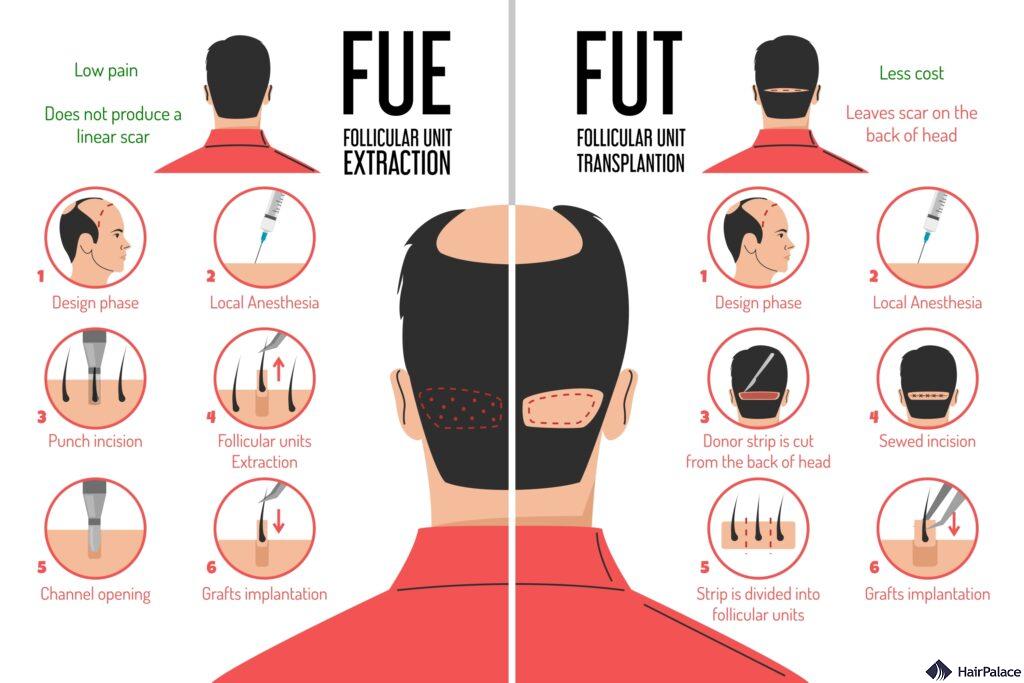
Which is better?
The most popular method is the FUE hair transplantation treatment. Only 3 years ago, most procedures were carried out with the FUT method.
However, today 66% of all hair restoration surgeries are performed using the FUE instead.
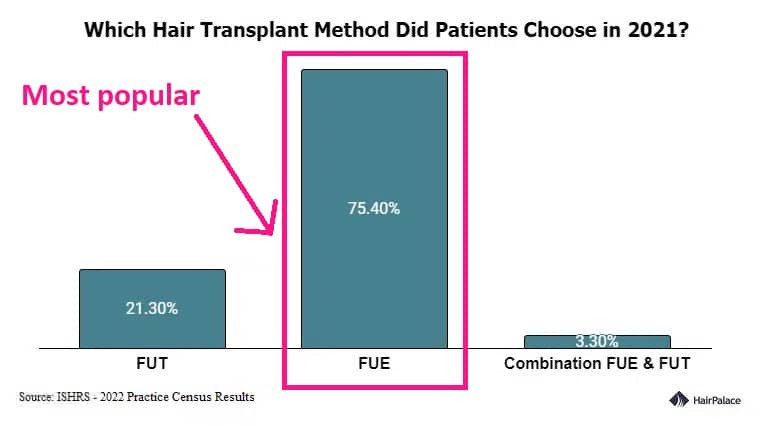
The FUT or strip harvesting technique still carries out 30% of all procedures.
As FUT also provides permanent results, it can be a feasible option in several cases.
Listen to our expert János as he explains the differences and similarities between FUT and FUE.
What are the advantages of FUT?
- The procedure is usually faster
- Prices can be lower
- Procedures usually involve a larger number of grafts
Key differences between the FUE and FUT methods
| FUE | FUT | |
|---|---|---|
| Anaesthesia | local | local |
| Extraction method | Punch extraction | Slit extraction with scalpel |
| Stitches required | no | yes |
| Extensive bleeding during or after surgery | may occur | no |
| Pain after surgery | none | moderate |
| Scarring on the donor area | untraceable | 5-15 cm long linear scar |
| Wearing short hair in the donor area | possible | not possible |
| Recovery period | 7-10 day | around 14 days |
| Return to work | 1-2 days after surgery | 7 days after surgery |
| Suture removal | – | 10-14 days post-op |
| Average costs | 3000-10000 | 1000-9000 |
FUT and FUE combined
Some clinics offer FUT and FUE transplants combined. Using the techniques combined is typically discussed and decided in advance.
It can also happen that the patient opts for a FUT procedure, but the surgeon finds that the scalp is too tight to proceed with this method.
The surgeon will usually decide if the treatment can be finished with the FUE or it can be performed at another time in the future.
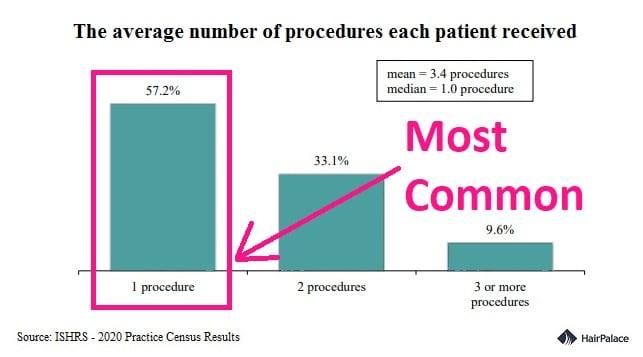
While in almost 60% of the cases, a single hair transplant session is enough to achieve the desired result, you might need another procedure in the future.
After a FUT procedure, it is possible to have another session with a different method.
Potential side effects of FUT surgery

FUT is a routine procedure nowadays, which means that the risk of complications is rather low.
However, some side effects of FUT after the surgery include:
- unnatural results
- scarring
- inflamed hair follicles (folliculitis)
- pain
- numbness
- swelling
- cysts
FUT hair transplant scar
FUT leads to a large permanent scar at the donor area.
While this scar will likely fade over time, it will remain visible.
The size of this scar will depend on the number of hair follicles extracted for your surgery.
It’s possible to cover this scar with the surrounding hair, but if you prefer shorter hairstyles it will be easily noticeable.
Shock hair loss
Shock hair loss or Donor hair effluvium is one of the most common FUT complications.
Around 2 months after the surgery your implanted hairs will fall out.
While this can be concerning, it is actually a sign that new hair growth has started.
Is FUT worth it?
The hair transplant surgeons of The Hair Loss Show explain the pros and cons of FUT transplantation.
FUT hair transplant recovery time
The full recovery takes around 2-3 weeks.
Though your surgeon will advise you about the aftercare and the products you should use, your recovery timeline will likely go as follows:
- After surgery: Remove the bandages
- 1 day after FUT: Start using the medicated products to keep the sutured area clean.
- 2 days after surgery: Avoid alcohol, caffeine and spicy food to prevent bleeding.
- 7-10 days after surgery: You may return to work.
- 10-14 days after surgery: Visit your surgeon to remove stitches.
- 3-4 weeks after FUT: The transplanted hairs fall out.
- 3-4 months after FUT: New regrowth starts on the implanted area and the density will gradually improve
- 6-8 months after treatment: You will notice a significant change in the density
- 12-15 months after FUT: You will see the complete result.
You will see the result of your FUT procedure around a year after the surgery.
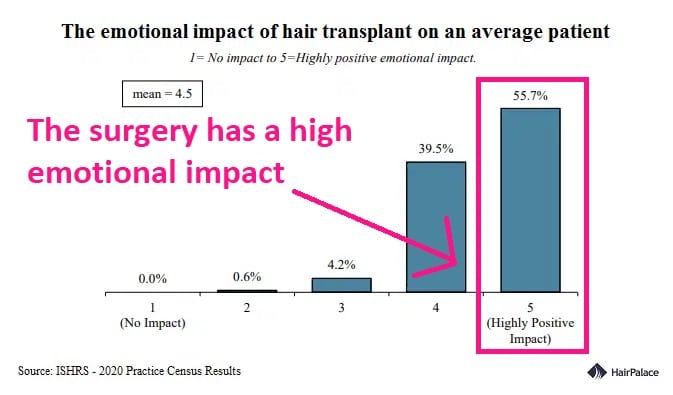
If carried out by experts, Follicular Unit Transplantation can offer you dense results that will boost your confidence.
FUT surgery can be more beneficial than FUE hair transplants for those who have a fear of hair transplant holes.
Though you will have to consider the potential drawbacks of the method, the result will likely have an overall positive impact and may make it up for you.
Learn more about hair transplant methods
If you want to learn more about different hair restoration techniques, check out the following articles!
- DHI hair transplant
- Biograft hair transplant
- Hair plugs
- Stem cell hair transplant
- Beard transplants
- Synthetic hair transplant
FUT Hair Transplant FAQ
FUT transplants cost between £1,000 and £10,000 in the UK on average, though prices vary. Some clinics will charge significantly more than others. Factors that affect costs include the number of hairs to be transplanted and the clinic’s location.
A FUT procedure is permanent; however, the patient may continue to experience natural hair loss in non-transplanted areas over time.
After a FUT surgery, sleep in an elevated position, preferably on your back, to avoid putting pressure on the transplanted area and to minimize swelling. Use pillows to prop yourself up. Avoid sleeping on your side or stomach for the first few days.
FUE (Follicular Unit Extraction) and FUT (Follicular Unit Transplantation) are two primary methods of hair transplantation:
-FUE: Individual hair follicles are extracted directly from the donor area and transplanted to the balding area.
-FUT: A strip of scalp is taken from the donor area, and then individual hair follicles are dissected and transplanted to the balding area.
The main difference lies in the method of extraction. In FUE individual hair follicles are extracted directly from the scalp, leaving no visible scars. In FUT a strip of scalp is removed from the donor area, leaving a linear scar, and then individual hair follicles are dissected from that strip.
The answer depends on your preferences. FUT usually allows for a higher graft yield at the cost of permanent scarring. On the other hand, FUE is less invasive offers a quicker recovery and doesn’t lead to any visible scars.
Last medically reviewed on January 2nd, 2025
- Bernstein R. Follicular unit hair transplantation. 2010.https://www.researchgate.net/publication/267451081_Follicular_Unit_Hair_Transplantation_2010
- Dua A, Dua K. Follicular unit extraction hair transplant. J Cutan Aesthet Surg. 2010;3(2):76-81. https://doi.org/10.4103/0974-2077.69015
- Kerure AS, Patwardhan N. Complications in hair transplantation. Symposium: Hair in Derm. 2018;11:4.http://dx.doi.org/10.4103/JCAS.JCAS_125_18
- Rose P. Hair restoration surgery: challenges and solutions. Clin Cosmet Investig Dermatol. 2015;8:361-370.https://doi.org/10.2147/CCID.S53980

